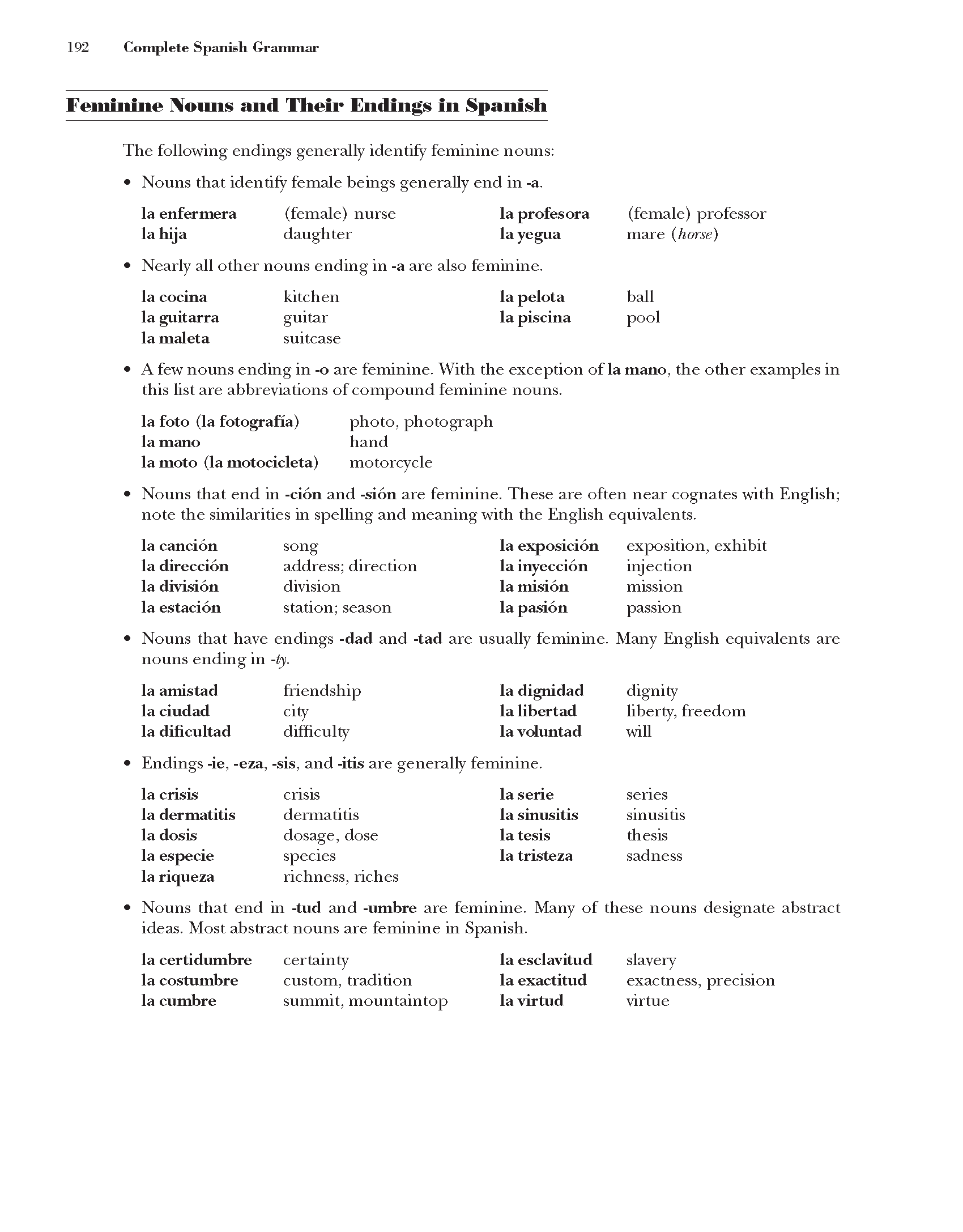CSG203

192 Complete Spanish Grammar
Feimiiine \oims and Their Endings in Spanish
The following endings generally identify feminine nouns:
• Nouns that identify female beings generally end in -a.
(female) professor marę (hor.se)
bali
pool
la enfermera (female) nurse la profesora
laliija daughter layegua
• Nearly all other nouns ending in -a are also feminine.
la cocina kitchen la pelota
la guitarra guitar la piscina
la maleta suitcase
• A few nouns ending in -o are feminine. With the exception of la mano, the other examples in this list are abbreviations of compound feminine nouns.
la foto (la fotografia) photo, photograph
la mano hand
lamoto (la motocicleta) motorcycle
• Nouns that end in -ción and -sión are feminine. These are often near cognates with English; notę the similarities in spelling and meaning with the English equivalents.
la canción la dirección la división la estación
la exposición la inyección la misión la pasión
song
address; direction division station; season
exposition, exhibit injection mission passion
• Nouns that have endings -dad and -tad are usually feminine. Many English equivalents are nouns ending in -ty.
la amistad la ciudad la dificultad
friendship
city
difficulty
la dignidad la libertad la yoluntad
dignity
liberty, freedom will
• Endings -ie, -eza, -sis, and -itis are generally feminine.
la crisis la dermatitis la dosis la especie la riqueza
crisis
dermatitis
dosage, dose species
richness, riches
la serie la sinusitis la tesis la tristeza
series
sinusitis
thesis
sadness
• Nouns that end in -tud and -umbre are feminine. Many of these nouns designate abstract ideas. Most abstract nouns are feminine in Spanish.
la esclavitud la exactitud la yirtud
slayery
exactness, precision virtue
la certidumbre certainty
la costumbre custom, tradition
la cumbre summit, mountaintop
Wyszukiwarka
Podobne podstrony:
CSG223 212 Complete Spanish Grammar • Masculine adjectives that end in -o drop the
Folia Medica Lodziensia, 2011, 38:177-200Current view about basophils and their significance in the
2.1 Introduction This chapter will give you a brief orientation of the nodes and their functions in
-. 1996. The State Against Society. Political Crises and their Aftermath in East Central Europę, Pri
SZELEGEJD, Barbara.: Red and black stoneware and their imitations in the Wilanów collection = poz. 7
Agata Paluch, Anna RodzeńForms of motivating employees and their usage in contemporary
3. A T. Jurdziński, Some results on RWW- and RRWW-Automata and Their Re-lationship
In comparing the API specs for L-80 and N-80 tubulars, which of the following statements is TRUE? A.
NOKIA Subsystems and network elements in GSM The EIR contains three lists: • A mob
GSM Architecture NOKIA3 Subsystems and network elements in GSM The GSM network is divided into three
74 (63) G R E E N “I retain from naturę a certain seąuence and a certain correctness in placing
431 (10) 404 Dress Accessońes —, 1987 ‘Report on the Composition of the Ingots and Axle-Cap’, in Mea
mobile print2 Telełubbies Mobile 1. Print out the sheets and colour them In. 2.Stick the sheets to a
CCF20100216�004 12 English Phonetics and Phonology ii) In making the two vowels described above, it
BA 292 MANAGEMENT INFORMATION SYSTEMS AND EXPERT SYSTEMS IN BUSINESS The course co
więcej podobnych podstron